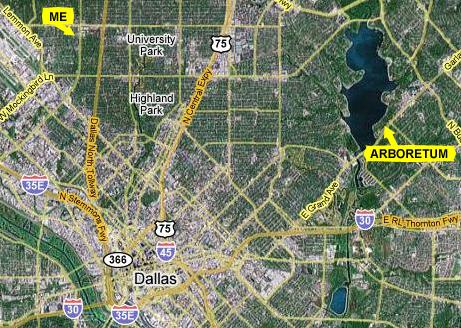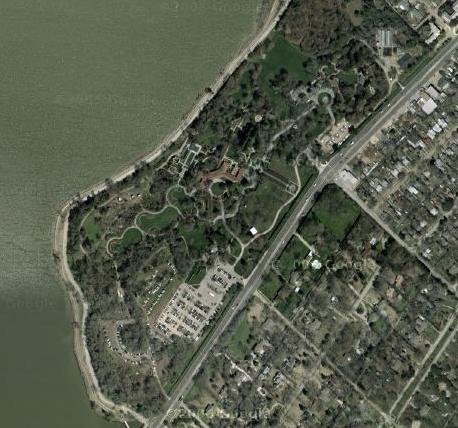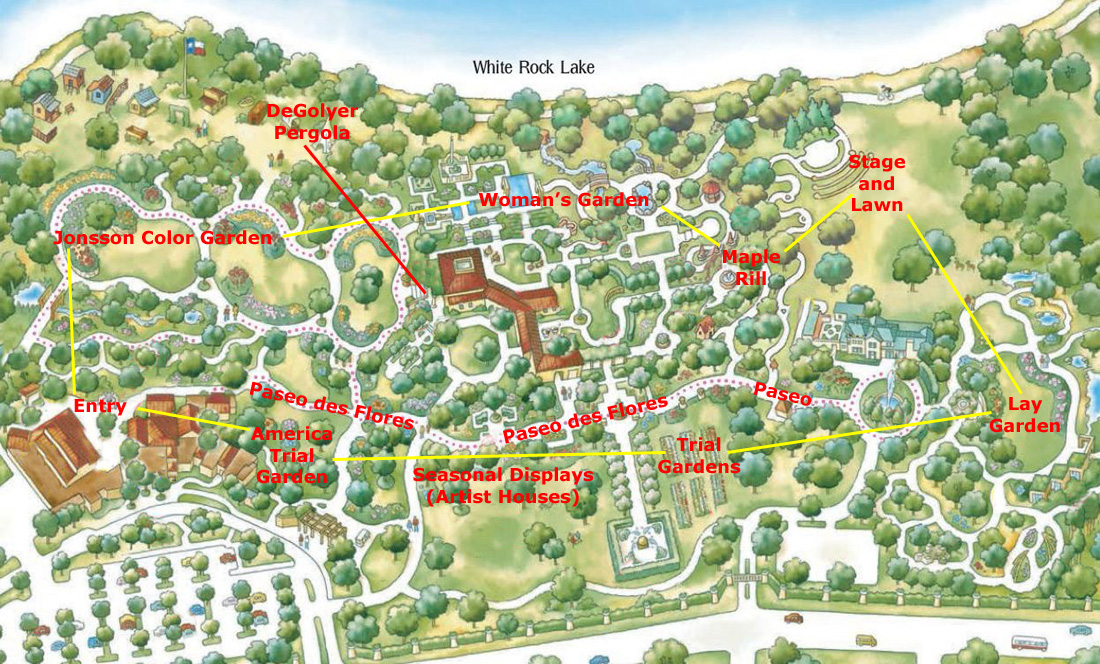


 |
March 28 - April 11, 2012 : A Trip to Fort Lauderdale |
 |
March 4, 2012: Dallas' Calatrava Bridge Opens |
 |
Return to the Index for 2012 |
Today, Fred and I along with our friends Mario and Steve have decided to go over to the Arboretum for their annual Fall pumpkin festival. Usually, we go just before Halloween, but the four of us have a week-long trip scheduled to New England next week, and then Fred has a visit to his Mom's to do and then we are going to Florida in the middle of October. So this was the best time to go- a good time as it turned out since the festival had just started and the number of pumpkins (they sell them throughout the festival) would be at their maximum. We had breakfast at the Original Pancake House on Lemmon Avenue on the way to the gardens.
Getting to the Dallas Arboretum
 |
 |
The bike path used to cross the top of the dam, but for one reason or another, the bike path was rerouted a year ago, and now it goes through some parkland and playing fields south of the dam, across the spillway, up Garland Road for a ways, and then back north along the lake shore.
You can also see a closer view of the Arboretum in this picture, and can begin to pick out some of the pathways through the gardens.
 |
You can also see the maze of pathways that criss-cross the gardens.
Although we usually make a circular transit of the entire Arboretum each time we visit, our primary purpose today is to have a good look at the new Nancy Rutchik Red Maple Rill, an area devoted to maples and water features that is situated between the Woman's Garden and the performance stage and lawn. As I have done for other visits, I have put a large diagram of the Arboretum below so you can see where we are:

|
I'll divide up today's pictures by garden, and with each group you'll find a little inset map with our current location marked. So let's head off on our walk through the Arboretum today.
Entry and Trammell Crow Visitor Education Pavilion
|
 |
The Jonsson Color Garden
|
The Jonsson Garden actually surrounds the infinity-symbol-shaped Main Lawn, which is an almost completely open space where visitors often spread out picnic blankets while children play. On the northwestern side of the western "lobe" of this space there is an arc-shaped bed that demonstrates gardening methods for this part of Texas, and offers advice on seasonal plants one might use. On the northeastern side of both "lobes" there are beds of seasonal flowers which always offer an amazing display. Today, they are dominated by tulips.
When we visit, we usually go around the western end of the Fern Dell (which we didn't visit today) and then around the north side of the main lawn along the banks of azaleas.
|
|
At the eastern end of the main lawn, there are steps leading up to the pergola at the west side of the old DeGolyer house. (The DeGolyer's actually lived on this property until their death, when they donated the house and land to establish the Arboretum.) There, we found a new sculpture that we hadn't seen before. Then we followed the walkway out from the northeast end of the Jonsson Garden to enter the relatively new Woman's Garden.
The Woman's Garden
|
|
The Nancy Rutchik Red Maple Rill
|
 |
The main design elements include a new entry off the Paseo de Flores, plus a large gathering plaza at the top of the rill. This plaza, where Fred is standing has two in-wall fountains and a view down the rill. A meandering creek with numerous waterfalls flows down the hillside, ending in a large pond. About halfway down the hill a stone bridge crosses the stream, connecting the paved walkways around the Rill with the Martin Rutchik Concert Lawn and the Magnolia Allee.
The most impressive feature is a collection of over 80 varieties of Japanese Maples. Two hundred trees are planted up and down the stream with an understory planting beneath the canopy. An especially large weeping Japanese maple nearly 100 years in age anchors the center of this new garden area. The rill is a horticulturally important garden with an impressive collection of Maple species and cultivars. Below are clickable thumbnails for some of Fred's views of this new garden:
 |
I made two movies here in the Maple Rill, and you can watch them with the players below:
|
The Meandering Stream in the Maple Rill |
A View of the Plaza and Maple Rill |
In the Lay Ornamental Garden
|
Both the Lay and Trammel Crow families are major participants in Dallas philanthropy. Trammel Crow began as a small property owner and Realtor, and his companies expanded to become a leading name in office rental properties and new construction nationwide. Herman Lay, who died in 1982, began as a Pepsi-Cola bottler in Mexico, and expanded into snack foods in the 1950s. His name is currently one-half of the famous Frito-Lay snack empire. Both men and their families have also been involved with the Morton Myerson Symphony Hall. The Trammel Crow family continues to sponsor concerts, and a branch of the Lay family donated the huge pipe organ that is the pride of the Myerson.
The Paseo de Flores
|
  |
The Trial Garden Beds
|

|
The All-American Trial Garden
|
 |
The Artist Houses
|
Over the years, the Arboretum has hosted various display exhibitions. One year, there were fanciful tree houses scattered throughout the gardens; another year there were huge wooden insects. More recently, there were fairytale houses in this area. Since the fairytale houses, there have always been four small buildings in this area, but their theme and decoration changes over time. Mostly for the kids, they are still interesting enough that adults can enjoy them.
The theme at the moment is "Famous Artists." The Arboretum has picked four famous artists and decorated each house as one would imagine would suit that artist and his or her style. Kids love to run around inside them (which is perfectly fine) while the adults can read the informational signs that are more their speed. Let me show you these current artist houses. For each one below, you can click on its small image to see a larger view, and you can click where indicated to read the sign that describes it.
|
|
|
|
We enjoyed the walk through the garden today, and I am sure we will be back soon for another visit.
You can use the links below to continue to another photo album page.
 |
March 28 - April 11, 2012 : A Trip to Fort Lauderdale |
 |
March 4, 2012: Dallas' Calatrava Bridge Opens |
 |
Return to the Index for 2012 |